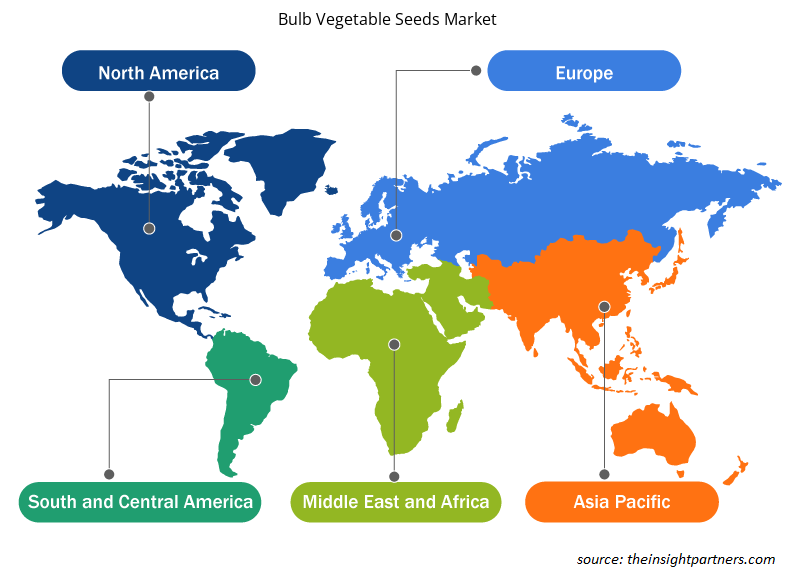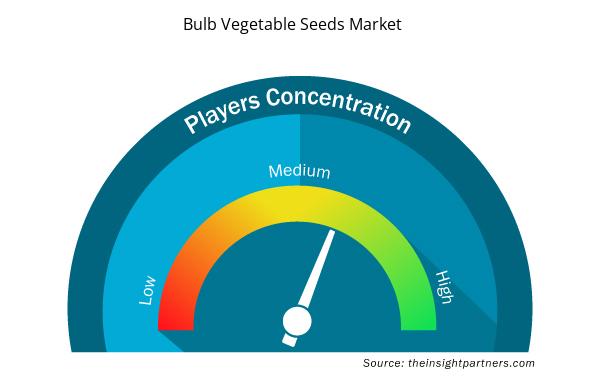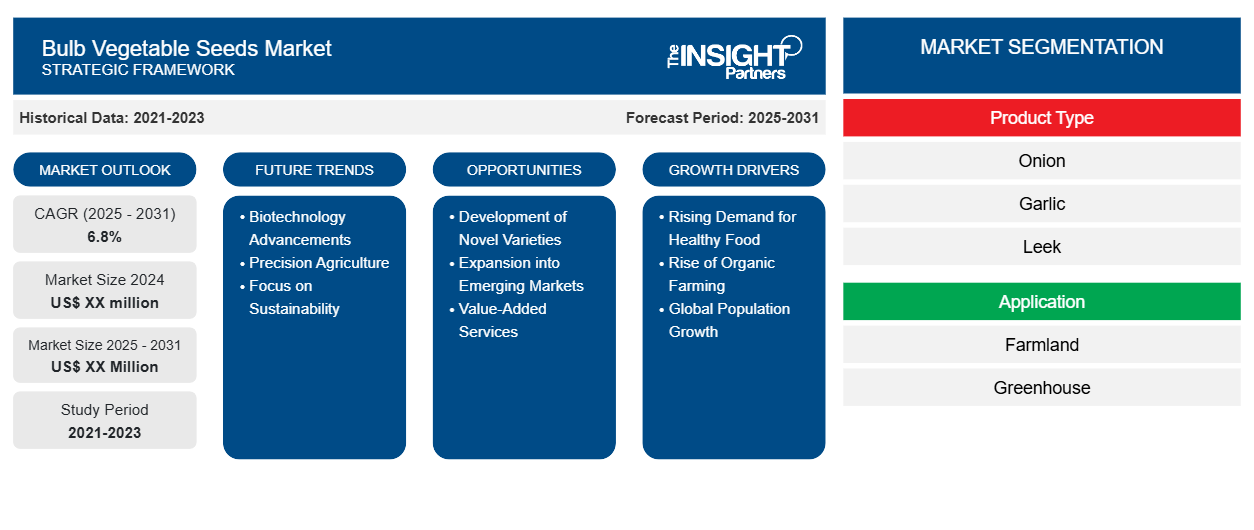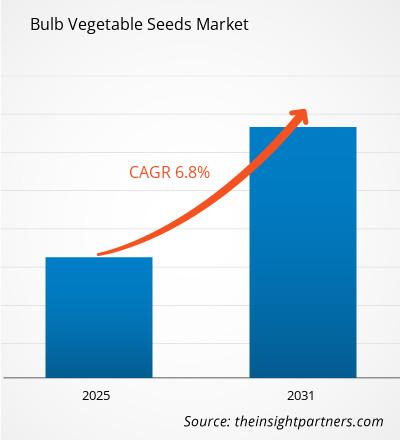Si prevede che il mercato dei semi di ortaggi a bulbo registrerà un CAGR del 6,8% dal 2023 al 2031, con una dimensione di mercato in espansione da XX milioni di dollari nel 2023 a XX milioni di dollari entro il 2031.
Il report è segmentato in base al tipo di prodotto (cipolla, aglio, porro e altri), applicazione (terreno agricolo, serra e altri). L'analisi globale è ulteriormente suddivisa a livello regionale e nei principali paesi. L'analisi globale è suddivisa a livello regionale e nei principali paesi. La valutazione di mercato è presentata in dollari USA per l'analisi segmentale di cui sopra.
Scopo del rapporto
Il report Bulb Vegetable Seeds Market di The Insight Partners mira a descrivere il panorama attuale e la crescita futura, i principali fattori trainanti, le sfide e le opportunità. Ciò fornirà spunti a vari stakeholder aziendali, come:
- Fornitori/produttori di tecnologia: per comprendere le dinamiche di mercato in evoluzione e conoscere le potenziali opportunità di crescita, consentendo loro di prendere decisioni strategiche informate.
- Investitori: condurre un'analisi completa delle tendenze in merito al tasso di crescita del mercato, alle proiezioni finanziarie del mercato e alle opportunità esistenti lungo la catena del valore.
- Enti di regolamentazione: regolamentano le politiche e le attività di controllo sul mercato allo scopo di ridurre al minimo gli abusi, preservare la fiducia degli investitori e sostenere l'integrità e la stabilità del mercato.
Segmentazione del mercato dei semi di ortaggi a bulbo
Tipo di prodotto
- Cipolla
- Aglio
- Porro
Applicazione
- Terreno agricolo
- Serra
Personalizza questo report in base alle tue esigenze
Riceverai la personalizzazione gratuita di qualsiasi report, comprese parti di questo report, o analisi a livello nazionale, pacchetto dati Excel, oltre a usufruire di grandi offerte e sconti per start-up e università
- Scopri le principali tendenze di mercato in questo rapporto.Questo campione GRATUITO includerà analisi di dati che spaziano dalle tendenze di mercato alle stime e alle previsioni.
Driver di crescita del mercato dei semi di ortaggi a bulbo
- Crescente domanda di cibo sano: la crescente consapevolezza dei consumatori sui benefici per la salute delle verdure a bulbo (cipolle, aglio, scalogno) sta determinando un aumento della domanda per la loro coltivazione.
- Ascesa dell'agricoltura biologica: la crescente preferenza per i prodotti biologici sta determinando una domanda di semi biologici di ortaggi a bulbo.
- Crescita della popolazione globale: l'espansione della popolazione mondiale richiede una maggiore produzione alimentare, compresa una maggiore domanda di ortaggi a bulbo nutrienti e versatili.
Tendenze future del mercato dei semi di ortaggi a bulbo
- Progressi nella biotecnologia: i progressi nella biotecnologia, come l'editing genetico, porteranno allo sviluppo di varietà migliorate di ortaggi a bulbo con resa maggiore, resistenza alle malattie e durata di conservazione maggiore.
- Agricoltura di precisione: l'adozione di tecniche di agricoltura di precisione, come l'analisi dei dati e l'automazione, ottimizzerà l'utilizzo dei semi e migliorerà le rese delle colture.
- Attenzione alla sostenibilità: la crescente attenzione all'agricoltura sostenibile favorirà lo sviluppo di sementi che richiedono meno acqua e meno input, riducendo al minimo l'impatto ambientale.
Opportunità di mercato per i semi di ortaggi a bulbo
- Sviluppo di nuove varietà: sviluppo di nuove varietà con sapore migliorato, maggiore conservabilità e resistenza a parassiti e malattie.
- Espansione nei mercati emergenti: esplorazione di nuovi mercati con una domanda crescente di prodotti freschi e una crescente consapevolezza dei consumatori verso un'alimentazione sana.
- Servizi a valore aggiunto: offerta di servizi a valore aggiunto agli agricoltori, come analisi delle sementi, consulenza sulle colture e supporto tecnico.
Approfondimenti regionali sul mercato dei semi di ortaggi a bulbo
Le tendenze regionali e i fattori che influenzano il mercato dei semi di ortaggi a bulbo durante il periodo di previsione sono stati ampiamente spiegati dagli analisti di Insight Partners. Questa sezione discute anche i segmenti e la geografia del mercato dei semi di ortaggi a bulbo in Nord America, Europa, Asia Pacifico, Medio Oriente e Africa e Sud e Centro America.

- Ottieni i dati specifici regionali per il mercato dei semi di ortaggi a bulbo
Ambito del rapporto di mercato sui semi di ortaggi a bulbo
| Attributo del report | Dettagli |
|---|---|
| Dimensioni del mercato nel 2023 | XX milioni di dollari USA |
| Dimensioni del mercato entro il 2031 | XX milioni di dollari USA |
| CAGR globale (2023-2031) | 6,8% |
| Dati storici | 2021-2022 |
| Periodo di previsione | 2024-2031 |
| Segmenti coperti | Per tipo di prodotto
|
| Regioni e Paesi coperti | America del Nord
|
| Leader di mercato e profili aziendali chiave |
|
Densità dei giocatori del mercato dei semi di ortaggi a bulbo: comprendere il suo impatto sulle dinamiche aziendali
Il mercato dei semi di ortaggi a bulbo sta crescendo rapidamente, spinto dalla crescente domanda degli utenti finali dovuta a fattori quali l'evoluzione delle preferenze dei consumatori, i progressi tecnologici e una maggiore consapevolezza dei benefici del prodotto. Con l'aumento della domanda, le aziende stanno ampliando la propria offerta, innovando per soddisfare le esigenze dei consumatori e capitalizzando sulle tendenze emergenti, il che alimenta ulteriormente la crescita del mercato.
La densità degli operatori di mercato si riferisce alla distribuzione di aziende o società che operano in un particolare mercato o settore. Indica quanti concorrenti (operatori di mercato) sono presenti in un dato spazio di mercato in relazione alle sue dimensioni o al valore di mercato totale.
Le principali aziende che operano nel mercato dei semi di ortaggi a bulbo sono:
- Scienza delle colture Bayer
- Bejo Zaden BV
- Seme Est-Ovest
- Enza Zaden
- Limagrain
- Rijk Zwaan Zaadteelt e Zaadhandel BV
Disclaimer : le aziende elencate sopra non sono classificate secondo un ordine particolare.

- Ottieni la panoramica dei principali attori del mercato dei semi di ortaggi a bulbo
Punti chiave di vendita
- Copertura completa: il rapporto copre in modo completo l'analisi di prodotti, servizi, tipologie e utenti finali del mercato dei semi di ortaggi a bulbo, fornendo una panoramica olistica.
- Analisi degli esperti: il rapporto è compilato sulla base della conoscenza approfondita di esperti e analisti del settore.
- Informazioni aggiornate: il rapporto garantisce la pertinenza aziendale grazie alla copertura di informazioni recenti e tendenze nei dati.
- Opzioni di personalizzazione: questo report può essere personalizzato per soddisfare le esigenze specifiche del cliente e adattarsi in modo appropriato alle strategie aziendali.
Il rapporto di ricerca sul mercato dei semi di ortaggi a bulbo può quindi aiutare a guidare il percorso di decodificazione e comprensione dello scenario del settore e delle prospettive di crescita. Sebbene possano esserci alcune preoccupazioni valide, i vantaggi complessivi di questo rapporto tendono a superare gli svantaggi.
- Analisi storica (2 anni), anno base, previsione (7 anni) con CAGR
- Analisi PEST e SWOT
- Valore/volume delle dimensioni del mercato - Globale, regionale, nazionale
- Industria e panorama competitivo
- Set di dati Excel



Report Coverage
Revenue forecast, Company Analysis, Industry landscape, Growth factors, and Trends

Segment Covered
This text is related
to segments covered.

Regional Scope
North America, Europe, Asia Pacific, Middle East & Africa, South & Central America

Country Scope
This text is related
to country scope.
Domande frequenti
Some of the customization options available based on request are additional 3-5 company profiles and country-specific analysis of 3-5 countries of your choice. Customizations are to be requested/discussed before making final order confirmation, as our team would review the same and check the feasibility.
The report can be delivered in PDF/PPT format; we can also share excel dataset based on the request.
The leading players are: Bayer Crop Science, Bejo Zaden BV, East West Seed, Enza Zaden, Limagrain, Rijk Zwaan Zaadteelt en Zaadhandel B V, Syngenta AG, Takii Co Ltd, KWS SAAT SE, FMC Corporation
Bulb Vegetable Seeds Market is expected to grow at a CAGR of 6.8% between 2023-2031
The future trends of the Bulb Vegetable Seeds Market are: Biotechnology Advancements, Precision Agriculture and Focus on Sustainability
The driving factors impacting the Bulb Vegetable Seeds Market are: Growing Demand for Healthy Food, Rise of Organic Farming and Global Population Growth
Trends and growth analysis reports related to Food and Beverages : READ MORE..
The List of Companies
1. Bayer Crop Science
2. Bejo Zaden BV
3. East-West Seed
4. Enza Zaden
5. Limagrain
6. Rijk Zwaan Zaadteelt en Zaadhandel B.V.
7. Syngenta AG
8. Takii and Co., Ltd.
9. The Monsanto Company
10. VoloAgri Group, Inc
The Insight Partners performs research in 4 major stages: Data Collection & Secondary Research, Primary Research, Data Analysis and Data Triangulation & Final Review.
- Data Collection and Secondary Research:
As a market research and consulting firm operating from a decade, we have published and advised several client across the globe. First step for any study will start with an assessment of currently available data and insights from existing reports. Further, historical and current market information is collected from Investor Presentations, Annual Reports, SEC Filings, etc., and other information related to company’s performance and market positioning are gathered from Paid Databases (Factiva, Hoovers, and Reuters) and various other publications available in public domain.
Several associations trade associates, technical forums, institutes, societies and organization are accessed to gain technical as well as market related insights through their publications such as research papers, blogs and press releases related to the studies are referred to get cues about the market. Further, white papers, journals, magazines, and other news articles published in last 3 years are scrutinized and analyzed to understand the current market trends.
- Primary Research:
The primarily interview analysis comprise of data obtained from industry participants interview and answers to survey questions gathered by in-house primary team.
For primary research, interviews are conducted with industry experts/CEOs/Marketing Managers/VPs/Subject Matter Experts from both demand and supply side to get a 360-degree view of the market. The primary team conducts several interviews based on the complexity of the markets to understand the various market trends and dynamics which makes research more credible and precise.
A typical research interview fulfils the following functions:
- Provides first-hand information on the market size, market trends, growth trends, competitive landscape, and outlook
- Validates and strengthens in-house secondary research findings
- Develops the analysis team’s expertise and market understanding
Primary research involves email interactions and telephone interviews for each market, category, segment, and sub-segment across geographies. The participants who typically take part in such a process include, but are not limited to:
- Industry participants: VPs, business development managers, market intelligence managers and national sales managers
- Outside experts: Valuation experts, research analysts and key opinion leaders specializing in the electronics and semiconductor industry.
Below is the breakup of our primary respondents by company, designation, and region:

Once we receive the confirmation from primary research sources or primary respondents, we finalize the base year market estimation and forecast the data as per the macroeconomic and microeconomic factors assessed during data collection.
- Data Analysis:
Once data is validated through both secondary as well as primary respondents, we finalize the market estimations by hypothesis formulation and factor analysis at regional and country level.
- Macro-Economic Factor Analysis:
We analyse macroeconomic indicators such the gross domestic product (GDP), increase in the demand for goods and services across industries, technological advancement, regional economic growth, governmental policies, the influence of COVID-19, PEST analysis, and other aspects. This analysis aids in setting benchmarks for various nations/regions and approximating market splits. Additionally, the general trend of the aforementioned components aid in determining the market's development possibilities.
- Country Level Data:
Various factors that are especially aligned to the country are taken into account to determine the market size for a certain area and country, including the presence of vendors, such as headquarters and offices, the country's GDP, demand patterns, and industry growth. To comprehend the market dynamics for the nation, a number of growth variables, inhibitors, application areas, and current market trends are researched. The aforementioned elements aid in determining the country's overall market's growth potential.
- Company Profile:
The “Table of Contents” is formulated by listing and analyzing more than 25 - 30 companies operating in the market ecosystem across geographies. However, we profile only 10 companies as a standard practice in our syndicate reports. These 10 companies comprise leading, emerging, and regional players. Nonetheless, our analysis is not restricted to the 10 listed companies, we also analyze other companies present in the market to develop a holistic view and understand the prevailing trends. The “Company Profiles” section in the report covers key facts, business description, products & services, financial information, SWOT analysis, and key developments. The financial information presented is extracted from the annual reports and official documents of the publicly listed companies. Upon collecting the information for the sections of respective companies, we verify them via various primary sources and then compile the data in respective company profiles. The company level information helps us in deriving the base number as well as in forecasting the market size.
- Developing Base Number:
Aggregation of sales statistics (2020-2022) and macro-economic factor, and other secondary and primary research insights are utilized to arrive at base number and related market shares for 2022. The data gaps are identified in this step and relevant market data is analyzed, collected from paid primary interviews or databases. On finalizing the base year market size, forecasts are developed on the basis of macro-economic, industry and market growth factors and company level analysis.
- Data Triangulation and Final Review:
The market findings and base year market size calculations are validated from supply as well as demand side. Demand side validations are based on macro-economic factor analysis and benchmarks for respective regions and countries. In case of supply side validations, revenues of major companies are estimated (in case not available) based on industry benchmark, approximate number of employees, product portfolio, and primary interviews revenues are gathered. Further revenue from target product/service segment is assessed to avoid overshooting of market statistics. In case of heavy deviations between supply and demand side values, all thes steps are repeated to achieve synchronization.
We follow an iterative model, wherein we share our research findings with Subject Matter Experts (SME’s) and Key Opinion Leaders (KOLs) until consensus view of the market is not formulated – this model negates any drastic deviation in the opinions of experts. Only validated and universally acceptable research findings are quoted in our reports.
We have important check points that we use to validate our research findings – which we call – data triangulation, where we validate the information, we generate from secondary sources with primary interviews and then we re-validate with our internal data bases and Subject matter experts. This comprehensive model enables us to deliver high quality, reliable data in shortest possible time.


 Ottieni un campione gratuito per questo repot
Ottieni un campione gratuito per questo repot